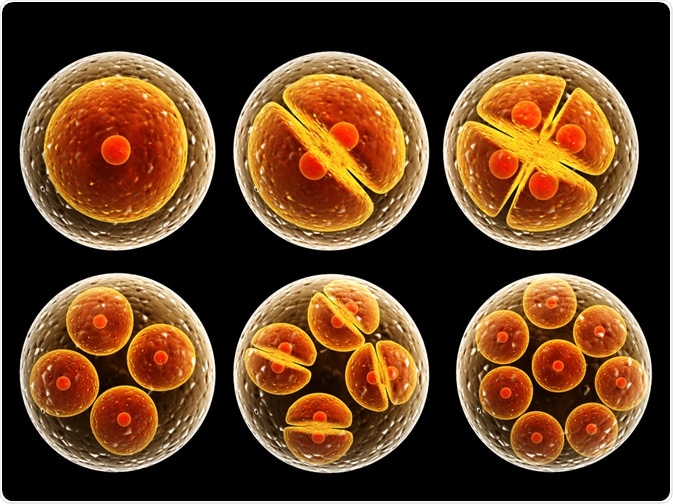The process of embryogenesis begins with an egg or ovum being fertilized by a sperm cell to form a zygote.

Image Credit: Lukiyanova Natalia frenta / Shutterstock.com
What is cleavage?
The zygote is a single diploid cell, which will ultimately multiply through mitotic division to form a multicellular embryo. This mitotic division does not result in any significant growth and the multicellular cluster that is formed is the same size as the zygote. This cell division process is referred to as cleavage.
Initially, at least four cycles of cell division occur, giving rise to 16 cells, referred to collectively as the morula. Around 24 hours after fertilization occurs, the first cleavage division occurs. The individual cells that are generated as a result of the cleavage are termed blastomeres and the cleavage phase ends when a hollow sphere of blastomeres called the blastula has formed. The ovum or egg cell has two poles and the pole where the yolk is most concentrated is referred to as the vegetal pole, while the opposite is called the animal pole.
Unlike other forms of cell division, cleavage gives rise to an increased cell number without increasing the mass. With each subdivision that occurs, there is an increase in the ratio of nuclear to cytoplasmic material. The frog blastula, for example, which is comprised of thousands of cells, is no larger than the egg is just after fertilization.
Types of cleavage
Cleavage may be total, which is referred to as holoblastic cleavage, or partial, which is otherwise known as meroblastic cleavage.
In eggs with no yolk or only a moderate amount of yolk, cytokinesis completely divides the cell and cleavage is holoblastic. Here, cleavage furrows are formed all the way through the zygote. This form of cleavage occurs in mammals such as humans. In the case of holoblastic cleavage, the offspring receive nourishment from the placenta or from the mother's milk after birth.
In animals where there is a rich supply of egg yolk, as is the case in both reptiles and birds, cytokinesis does not completely divide the egg and cleavage is meroblastic. Animals that undergo meroblastic cleavage obtain all of their nutrients from the egg.
In the hen, an egg is made up of a tiny area of cytoplasm that sits on the surface of a large area of yolk. During the first cleavages of the hen’s egg, cleavage furrows are not formed through the yolk’s mass. The cells produced are therefore bound on the top and sides by a plasma membrane. Only the bottom of each cell is in contact with the yolk.
Cleavage in insects
In insects, a different form of meroblastic cleavage occurs. Herein, the yolk is concentrated in the middle of the egg and nuclei generated through mitosis of the zygote nucleus stay inside the egg compartment until several thousand have been created. At this point, the nuclei migrate to the compartment of the egg that is rich in cytoplasm and a plasma membrane then forms around each of them.
What is achieved by cleavage?
As well as providing the cells required for the development of an embryo, cleavage allows for the regulatory relationship between cytoplasmic volume and the nucleus to be established. Cleavage gives rise to thousands of nuclei through mitosis, with all of these nuclei eventually being contained inside a cell that has regular dimensions.
References
Further Reading
Last Updated: Mar 11, 2023